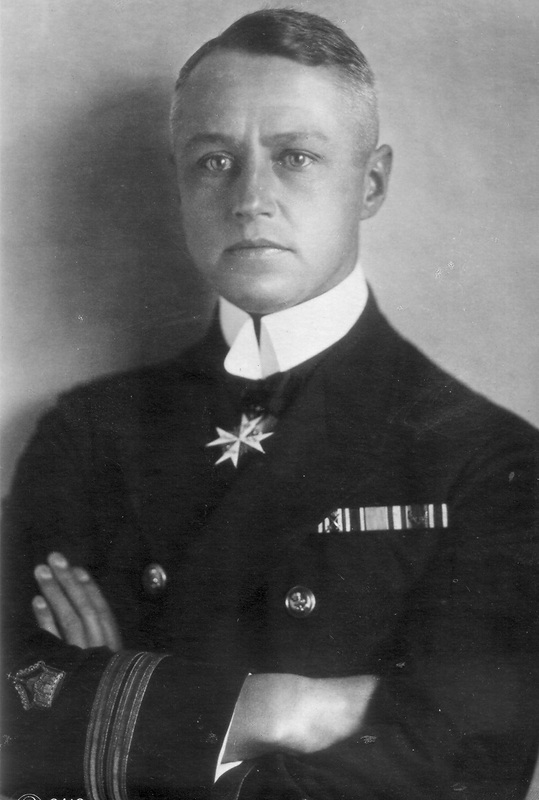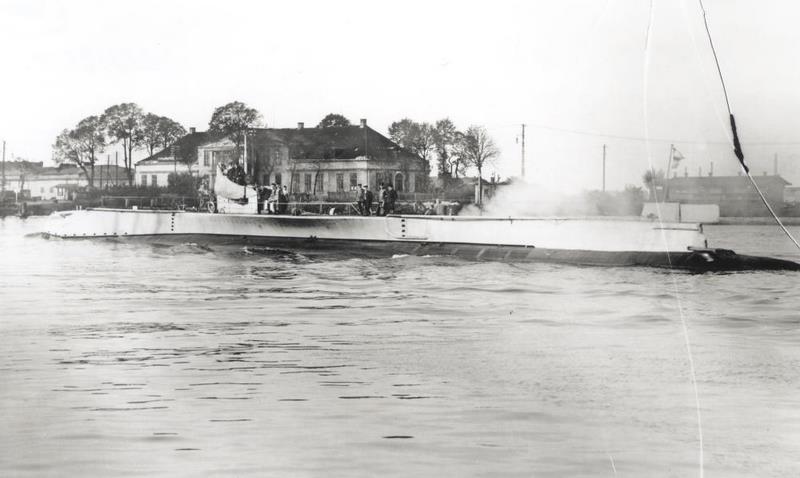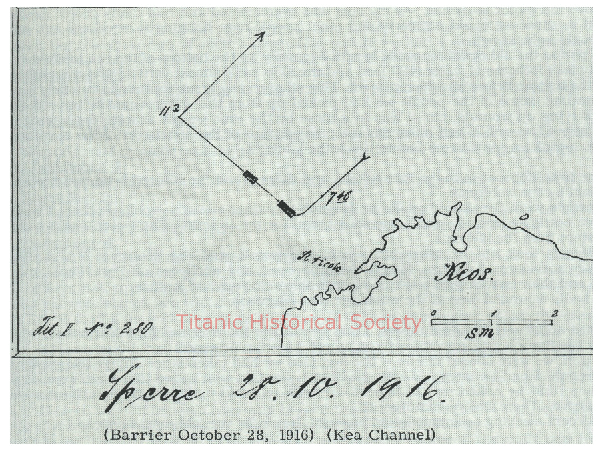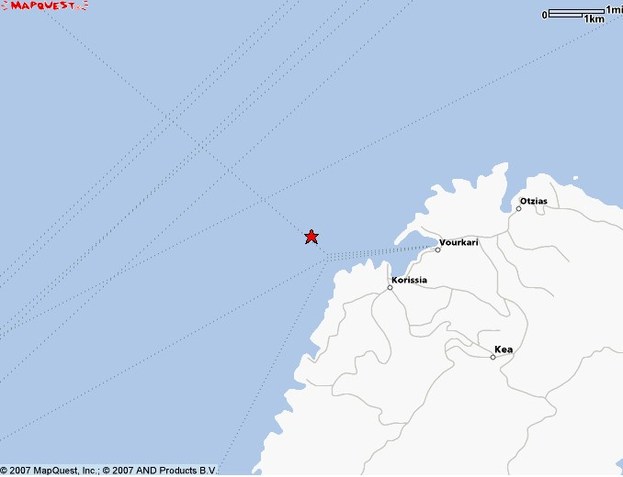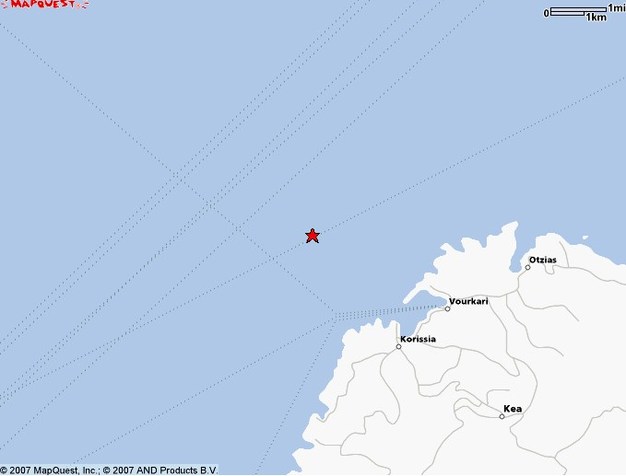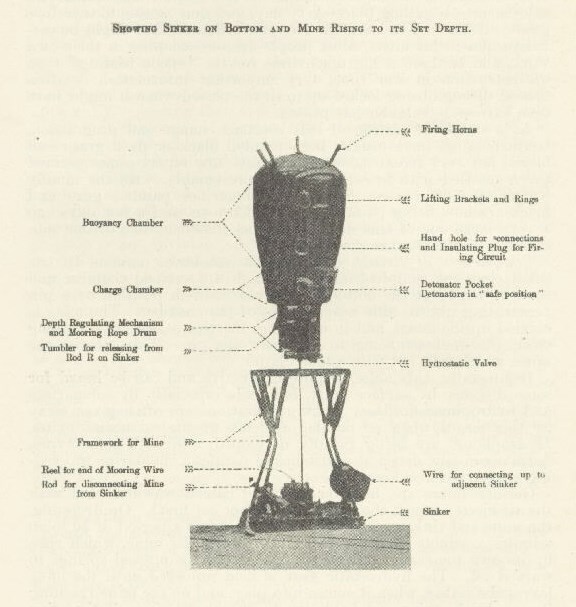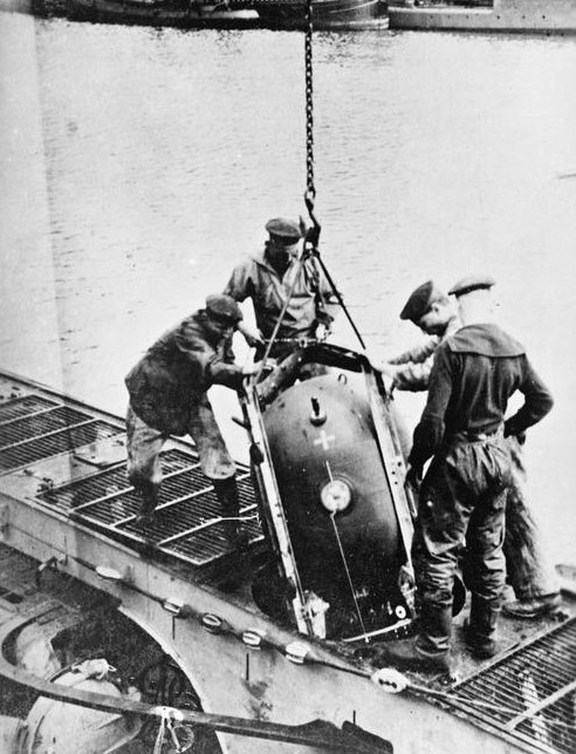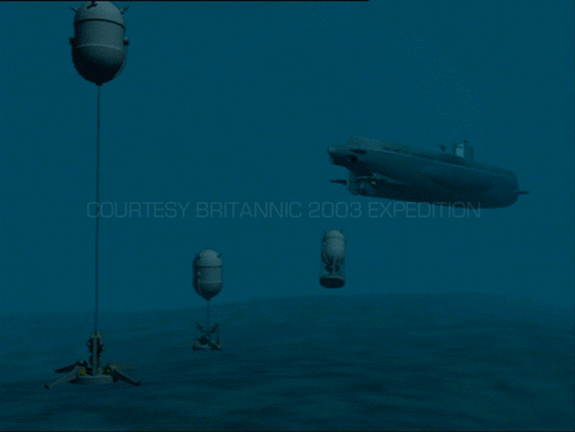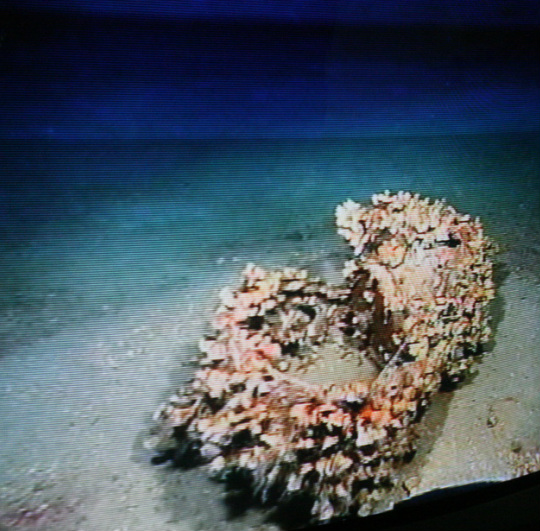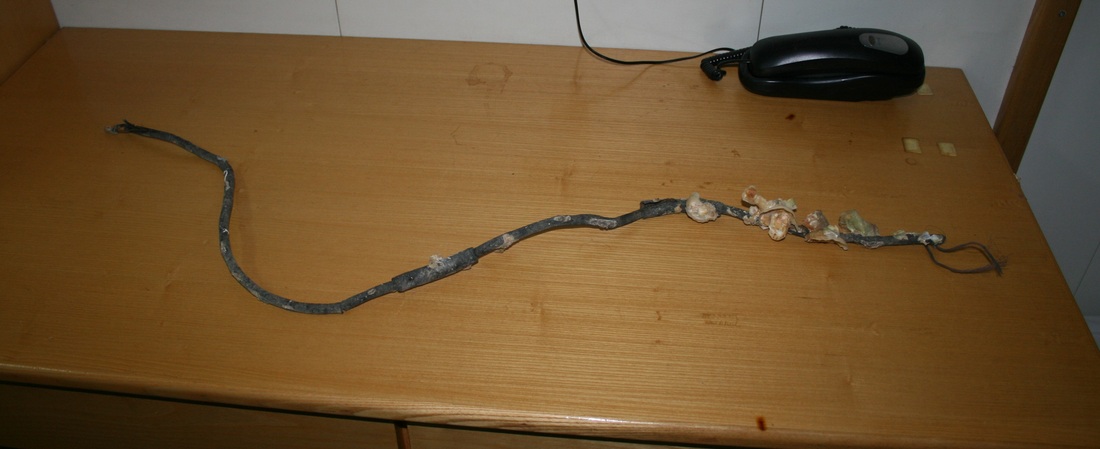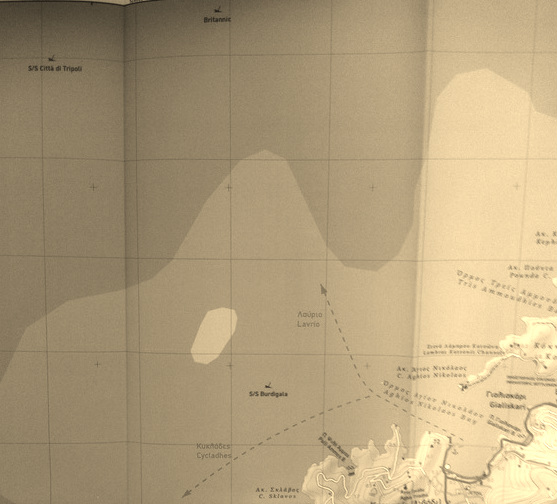THEORIES
By Michail Michailakis
Secondary explosion
The massive damage observed during the exploration of the wreck led to the formation of the theory of a secondary explosion produced by explosive material (es: secretly stored munitions) present in the forward cargo holds, despite the fact that the official casualty report (by Captain H.H.Heard and Engineer Commander G.H.Staer) clearly stated that the Britannic wasn't carrying any kind of cargo and that there was only one explosion.
After the first examination of the wreck in 1976 Jacques Y. Cousteau and his team concluded that these findings were a clear indication of a secondary explosion but no trace of any kind of explosive cargo was found in the holds or inside the debris field. The only remaining possibility was coal dust, which is indeed explosive when suspended into a certain volume of air. However, the divers of the 1999 expedition found that the hatch to hold #3 (the coal bunker) on the forward well deck was almost intact and the reserve coal bunker itself also seemed in very good condition. This was a major argument against this theory, considering that a coal dust explosion would have certainly followed the line of least resistance, causing extensive damage to the reserve coal bunker and blowing the hatch cover upwards.
A good starting point for the search for explosive materials, would be to examine the possible contents of the cargo holds. Unfortunately, since the Cargo Manifest of the ship is lost we can only speculate. Being a floating hospital capable of hosting more than 3000 patients, the Britannic would carry sufficient quantities of medical supplies for the entire duration of her round trip to England. In the past, it was suggested that ether was responsible for a secondary explosion. Ether was extensively used as an anesthetic gas during that period and its presence on the Britannic must be considered very probable. However, although ether is very flammable when mixed with air, it’s not explosive. Only the addition of pure oxygen or nitrous dioxide (another gas used in medicine) can produce an explosive mixture. But even if ether and nitrous dioxide were both stored in the holds, it is very unlikely that they would have been present in sufficient quantities to account for an explosion of this magnitude, if we consider that the large hospital ships were used for the final stage of the evacuation process from Moudros to England. Most –if not all- surgical cases onboard were under post-operatorious treatment and the use of aneshetetic gasses was hardly required. Nurse Daisy Spickett during a recorded oral account of her wartime experience on the Aquitania and the Britannic, when asked what type of cases were treated on these ships, stated that the majority involved dysenteric cases but there were also some surgical cases requiring regular changes of dressings.
After the first examination of the wreck in 1976 Jacques Y. Cousteau and his team concluded that these findings were a clear indication of a secondary explosion but no trace of any kind of explosive cargo was found in the holds or inside the debris field. The only remaining possibility was coal dust, which is indeed explosive when suspended into a certain volume of air. However, the divers of the 1999 expedition found that the hatch to hold #3 (the coal bunker) on the forward well deck was almost intact and the reserve coal bunker itself also seemed in very good condition. This was a major argument against this theory, considering that a coal dust explosion would have certainly followed the line of least resistance, causing extensive damage to the reserve coal bunker and blowing the hatch cover upwards.
A good starting point for the search for explosive materials, would be to examine the possible contents of the cargo holds. Unfortunately, since the Cargo Manifest of the ship is lost we can only speculate. Being a floating hospital capable of hosting more than 3000 patients, the Britannic would carry sufficient quantities of medical supplies for the entire duration of her round trip to England. In the past, it was suggested that ether was responsible for a secondary explosion. Ether was extensively used as an anesthetic gas during that period and its presence on the Britannic must be considered very probable. However, although ether is very flammable when mixed with air, it’s not explosive. Only the addition of pure oxygen or nitrous dioxide (another gas used in medicine) can produce an explosive mixture. But even if ether and nitrous dioxide were both stored in the holds, it is very unlikely that they would have been present in sufficient quantities to account for an explosion of this magnitude, if we consider that the large hospital ships were used for the final stage of the evacuation process from Moudros to England. Most –if not all- surgical cases onboard were under post-operatorious treatment and the use of aneshetetic gasses was hardly required. Nurse Daisy Spickett during a recorded oral account of her wartime experience on the Aquitania and the Britannic, when asked what type of cases were treated on these ships, stated that the majority involved dysenteric cases but there were also some surgical cases requiring regular changes of dressings.
Damage analysis
In order to explain the great magnitude of the observed damage, it is essential to examine the sequence of events that took place from the moment of the explosion. When an explosive device detonates underwater it creates a superheated, highly compressed, gas bubble and a spherical pressure wave (shock-wave) which originally propagates much faster than the speed of sound. The pressure of the shock-wave arrives at its peak value almost instantly, but then it decays exponentially. As the velocity of the shock-wave drops to the speed of sound the gas bubble expands and the pressure inside it decreases. The gas bubble reaches its maximum radius when the pressure of the water around it (hydrostatic pressure) becomes greater than the pressure inside it. At this point the bubble contracts and as its volume decreases the pressure inside it increases again. This cycle (bubble pulse) may be repeated several times. As the bubble is boyant it migrates versus the surface. If the gas bubble is too large, then it may collapse upon itself creating a toroid-shaped bubble and a collumn (jet) of water moving upwards. If the explosion takes place right under a ship, the bubble pulse and the water collumn can produce devestating effects on her hull structure.
If the detonation occurs on the ship's hull an opening is created and the bulkheads in the vicinity of the explosion are damaged due to direct exposure to the shock-wave or to deformation produced as a result of the deformation of the hull. However, this damage usually doesn't extend far into the ship nor in the fore-and-aft direction. If the vessel has a double bottom a significant amount of the kinetic energy of the shock-wave is consumed in order to bend the longitudinal and transverse beams of its structure. The rest of the kinetic energy is transmitted from the bottom to the bulkheads and then to the upper decks, creating an upward motion (hull-whipping response) which deforms the bottom between bulkheads. The expansion of the gas bubble can also inflict significant hull plating damage locally. If the explosion occurs near the surface the gases produced may blow out of the water and there is no bubble pulse.
This is how the explosion and its effects on the Britannic were reported in surviving reports and personal accounts:
If the detonation occurs on the ship's hull an opening is created and the bulkheads in the vicinity of the explosion are damaged due to direct exposure to the shock-wave or to deformation produced as a result of the deformation of the hull. However, this damage usually doesn't extend far into the ship nor in the fore-and-aft direction. If the vessel has a double bottom a significant amount of the kinetic energy of the shock-wave is consumed in order to bend the longitudinal and transverse beams of its structure. The rest of the kinetic energy is transmitted from the bottom to the bulkheads and then to the upper decks, creating an upward motion (hull-whipping response) which deforms the bottom between bulkheads. The expansion of the gas bubble can also inflict significant hull plating damage locally. If the explosion occurs near the surface the gases produced may blow out of the water and there is no bubble pulse.
This is how the explosion and its effects on the Britannic were reported in surviving reports and personal accounts:
Official report by Captain Hugh Heard and Commander George Staer:
“3. There was one explosion only. This took place on Starboard side low down and in the vicinity of the bulkhead between 2 and 3 holds, breaking this bulkhead and thus filling Nos. 2 & 3 holds.Whether the bulkhead between Nos 1 &2 holds was broken is not certain, but it is probable. Anyway No.1 hold also filled either in this way or through the tunnel”
4. It appears that the bulkhead between No. hold & No.6 Stokehold was not broken, but water from the holds gained free access through the W.T. door between stokehold and tunnel which was not closed, the tunnel having been broken.
5. Water also had free access to No.5 Stokehold through the W.T. Door between 5 and 6. It is clear that this door was not wholly, although there is evidence to show that it may have been partly, closed.”
Official report by Captain Charles Alfred Barlett:
“…a tremendous but muffled explosion occurred, the ship trembling and vibrating most violently fore and aft, continuing for some time; the ship fell off about 3 points from her course.”
“The damage was most extensive, probably the whole of the fore part of the ship’s bottom being destroyed and in my opinion penetrating to No.6 boiler room. Water was seen to be thrown up to E or D deck forward at the time of the explosion, and a cloud of black smoke was seen, the fumes for some time being suffocating.”
Percy Tyler’s account (RAMC Private, G Deck):
“…there was a violent bump, which sent me forward a few paces and back then the boat regularly danced. […] Aft the shock was more violent, some were thrown completely off their feet. For’ard where the boat was hit was a very different scene.”
Newspaper account (Nov.25, 1916):
"...The ship, it is stated, was struck well forward on the starboard side , the hatches of No.2 hold being blown fifty feet [15m] up into the air and the decks covered with splinters......"
Bert Smith's account (Stoker, Boiler Room No.6):
"..there was a very loud bang. Almost instantly this was followed by a massive explosion - just in front of number one stokehold, where Bert was on duty. Shocked and covered in coal dust, Bert Smith groped his way into the exit tunnel, his one route to possible safety. There he was met by the full weight of inrushing water, which briefly pinned him against the boiler..."
Violet Jessop (Stewardess, Dining Room):
"Suddenly, there was a dull deafening roar. Britannic gave a shiver, a long drawn out shudder from stem to stern, shaking the crockery on the tables, breaking things till it subsided as she slowly continued on her way."
Britannic's Fourth Officer (Officer's Quarters, Boat Deck):
"...At the time of the explosion I was not dressed, having just had my bath, and was shaving in my cabin -which was about 10 yards distant from the point of contact. I was thrown very forcibly across the cabin with sundry articles of gear on top of me. The boat lifted twice, and everything seemed to dance, and the fumes from the explosions temporarily blinded me..."
Thomas Walters (Steward, forward starboard Promenade Deck):
"...I then looked down at the water but had to hold my nostrils on account of the fumes which were stifling. I could see what appeared to be a great disturbance of the water occuring aft."
The direct damage was quite extensive, as the vessel's width at the point of impact was relatively small. According to the official reports, apart from the hole created by the explosion, the watertight bulkhead between the two holds and the watertight firemen's tunnel running through it suffered major damage. If the testimony regarding the blow-up of the cover of the hatch to Hold #2 is accurate, then it is quite safe to assume that most of the energy released by the detonation affected Hold #2 and also broke the bulkhead between it and Hold #1. The perforation of the firemen's tunnel produced an additional source of flooding in Hold #1, as the tunnel's top entrance was not watertight and was located FORWARD of the bulkhead between Holds #1 and #2. The covers above the hatchways #1 and #3 were found in their places during the diving expeditions.
The testimonies regarding the irritating fumes, the black smoke and the disturbances on the water suggest that the gas bubble produced by the explosion arrived on the surface within seconds and a bubble pulse did not occur. This is also confirmed by the fact that there was no observation of a water jet (water was thrown only up to D deck) following a collapse of the gas bubble. On the contrary, it must be considered certain that the expansion of the gas bubble before its arrival on the surface created additional hull-plating damage near the point of impact. The effect of the gas bubble expansion, along with the direct damage from the shock wave, possibly broke some of the riveted seams on the starboard side and allowed water to enter into the spaces determined by the double bottom, as Captain Bartlett suggested in his report. This could explain the almost immediate list to starboard, which contributed to the sinking by placing the open portholes of the lower decks under water soon after the explosion.
The transfer of the kinetic energy across the Britannic produced a hull-whipping response (the ship lifted twice, moved to port by 3 degrees and vibrated violently) which certainly deformed the hull itself and the bulkheads located closer to the area affected by the explosion. The latter is also suggested by the operating failure of all the watertight doors forward of Boiler Room #4. On the Olympic-class liners the guides for the lowering of the watertight doors were mounted directly on the bulkhead, a design feature that increased the risk of the doors getting jammed in case of severe bulkhead deformation. The hull's response to the explosion is also suspect of producing additional damage to the double bottom and of causing the failure of the steering gear, which forced Captain Bartlett to altnernate the power between the propellers in order to execute the right turn to the island of Kea. The damage created by the dynamics of the sinking is discussed in the Wreck section of this website.
The testimonies regarding the irritating fumes, the black smoke and the disturbances on the water suggest that the gas bubble produced by the explosion arrived on the surface within seconds and a bubble pulse did not occur. This is also confirmed by the fact that there was no observation of a water jet (water was thrown only up to D deck) following a collapse of the gas bubble. On the contrary, it must be considered certain that the expansion of the gas bubble before its arrival on the surface created additional hull-plating damage near the point of impact. The effect of the gas bubble expansion, along with the direct damage from the shock wave, possibly broke some of the riveted seams on the starboard side and allowed water to enter into the spaces determined by the double bottom, as Captain Bartlett suggested in his report. This could explain the almost immediate list to starboard, which contributed to the sinking by placing the open portholes of the lower decks under water soon after the explosion.
The transfer of the kinetic energy across the Britannic produced a hull-whipping response (the ship lifted twice, moved to port by 3 degrees and vibrated violently) which certainly deformed the hull itself and the bulkheads located closer to the area affected by the explosion. The latter is also suggested by the operating failure of all the watertight doors forward of Boiler Room #4. On the Olympic-class liners the guides for the lowering of the watertight doors were mounted directly on the bulkhead, a design feature that increased the risk of the doors getting jammed in case of severe bulkhead deformation. The hull's response to the explosion is also suspect of producing additional damage to the double bottom and of causing the failure of the steering gear, which forced Captain Bartlett to altnernate the power between the propellers in order to execute the right turn to the island of Kea. The damage created by the dynamics of the sinking is discussed in the Wreck section of this website.
The big question: Mine or torpedo?
Among Britannic researchers there is a consensus that the ship sank after hitting a moored contact mine, laid by the mine-laying submarine U73 of the German Mediterranean Submarine Flotilla (Deutsche U-Flottille Pola), commanded by Kapitänleutnant Gustav Siess. This opinion is mainly based on two key pieces of information contained in the German and Austrian naval archives and released after the end of the war. The first comes from the log of the U73, which confirms the laying of “Minefield 32” (two mine barriers, each consisting of 6 mines) in the Kea Channel, on October 28, 1916. It's believed that the mines from the U73 also sank the French armed auxiliary cruiser S/S Burdigala (ex S/S Kaiser Friedrich) on November 14, 1916, and badly damaged the British hospital ship HMHS Braemar Castle on November 23. According to the coordinates provided by U73’s crew one of the two mine barriers was laid very close to the actual location of Britannic’s wreck. The second emerged from the study of the well-documented movements of all the German submarines in the Mediterranean in November 1916. This study showed that no submarine was operating in the region of the Kea Channel on the day the Britannic was lost. The U73 had departed for its base at Cattaro on November 4, 1916 and arrived there on November 7 in order to undergo repairs.[1] As a result, the scenario of a torpedo attack is generally considered to be nothing more than a fantasy of unreliable eye-witnesses who were hugely intimidated by the lethal efficiency of the German submarine campaign. Some researchers think that the British never officially discredited this scenario for reasons of wartime propaganda, largely focused on the “brutality” of their enemies. At first glance, the evidence in favor of a mine explosion as the cause of the sinking of the Britannic looks very solid. However, this doesn’t appear to be the case and this analysis has the purpose to highlight the reasons why the “Mine vs Torpedo” debate should remain open.
Operation of the German moored contact mines
The moored contact mine was the most widely used during WW1. This mine consisted of:
- A mine casing, spherical or cylindrical, divided into a buoyancy chamber and charge chamber. It also contained the firing mechanism.
- A sinker or anchor, serving to hold the mine on the sea bottom.
- A mooring rope or wire, serving to connect the mine casing to the sinker and keep the mine at a predetermined depth, through the use of a depth-regulating mechanism.
The type of the firing mechanism was known as “Herz-horn” because of the soft lead rods (or “horns”) protruding from the body of the mine casing. Encased inside these rods were glass tubes containing a liquid chemical mixture (a battery electrolyte). Upon contact with a passing ship, the soft rods would bend, breaking the glass tubes and releasing the liquid mixture into a container equipped with metal plates connected to a battery. Once inside the container, the liquid mixture would generate electricity through electrolysis and ignite the fuse that was connected to the explosive. The amount of elapsed time, from the ship’s impact to the explosion of the mine, was dependent on the speed of the electrolytic process. The explosive charge of choice was wet gun-cotton (explodes at <3000 m/s), but TNT (explodes at 6900m/s) was also used.
The two standard types of moored contact mines developed by the Germans were: the EMA (151Kg/331lb of wet gun-cotton) and the EMB (225kg/497lb of TNT). Their operating depth was up to 150m/492ft and they were not laid by submarines. The German mine-laying submarines were equipped with different types of mines: either the UC 120 (120kg/264lb of explosive) or the UC 200 (200kg/441lb of explosive). The total length of the mooring rope for both types was 100m/328ft and their diameter was 80cm/31.5in. [2]
The moored contact mine was the most widely used during WW1. This mine consisted of:
- A mine casing, spherical or cylindrical, divided into a buoyancy chamber and charge chamber. It also contained the firing mechanism.
- A sinker or anchor, serving to hold the mine on the sea bottom.
- A mooring rope or wire, serving to connect the mine casing to the sinker and keep the mine at a predetermined depth, through the use of a depth-regulating mechanism.
The type of the firing mechanism was known as “Herz-horn” because of the soft lead rods (or “horns”) protruding from the body of the mine casing. Encased inside these rods were glass tubes containing a liquid chemical mixture (a battery electrolyte). Upon contact with a passing ship, the soft rods would bend, breaking the glass tubes and releasing the liquid mixture into a container equipped with metal plates connected to a battery. Once inside the container, the liquid mixture would generate electricity through electrolysis and ignite the fuse that was connected to the explosive. The amount of elapsed time, from the ship’s impact to the explosion of the mine, was dependent on the speed of the electrolytic process. The explosive charge of choice was wet gun-cotton (explodes at <3000 m/s), but TNT (explodes at 6900m/s) was also used.
The two standard types of moored contact mines developed by the Germans were: the EMA (151Kg/331lb of wet gun-cotton) and the EMB (225kg/497lb of TNT). Their operating depth was up to 150m/492ft and they were not laid by submarines. The German mine-laying submarines were equipped with different types of mines: either the UC 120 (120kg/264lb of explosive) or the UC 200 (200kg/441lb of explosive). The total length of the mooring rope for both types was 100m/328ft and their diameter was 80cm/31.5in. [2]
In the case of the UE-type submarines, such as the U-73, the mines were loaded into a dry mine storage compartment and then dropped into the water from horizontal ejection tubes at the stern. [3] The mooring rope was not immediately deployed for safety reasons. After 10-20 minutes a soluble plug was dissolved and the mine was released by the inertia of compressed springs and its own buoyancy. Once the mine arrived at the predetermined depth the depth-regulating gear would grip and block permanently the mooring rope. Another soluble plug was acting as safety gear, keeping the mine unarmed inside the dry storage of the submarine but activating it once it was dissolved by the water. [4]
The mine theory
The British Officers in charge of the inquiry over the loss of the Britannic had to deal with the limited time at disposal and the inability to locate the witnesses, as the survivors had been already moved to various ships around the Allied fleet soon after their arrival at Pireaus. Their controversial conclusion reflects the fact that there were testimonies in support of a torpedo attack:
The British Officers in charge of the inquiry over the loss of the Britannic had to deal with the limited time at disposal and the inability to locate the witnesses, as the survivors had been already moved to various ships around the Allied fleet soon after their arrival at Pireaus. Their controversial conclusion reflects the fact that there were testimonies in support of a torpedo attack:
"The effects of the explosion might have been due to either a mine or a torpedo; the probability seems to be a mine".
Considering that the existence of "Minefield No.32" in the Kea Channel is certain, we must examine if the Britannic sailed indeed into it or not. Here is what the official sources have to offer: [5]
"Water was deep, probably over 100 fathoms [aprox.182.9m] and there is a current through the Zea Channel. This against the mine theory."
[Official inquiry over the loss of HMHS Britannic - November 24,1916]
"The explosion occured whilst the Britannic was in about 65 fathoms [aprox.119m] of water, and a mine could have been the cause [...]"
[Captain Bartlett's official report - November 30, 1916]
We see that there is a significant difference between the two depth figures. Regardess of which source is right, it must be taken into account that the maximum length of the mooring rope of the UC-type mines was 54.7 fathoms/100m. Surely, the crew of the U73 must have laid their mines in much shallower waters.
There is also the testimony of the Navigator of the U73, Martin Niemöller, which describes the situation in the Kea Channel the day the mines were laid [6]:
There is also the testimony of the Navigator of the U73, Martin Niemöller, which describes the situation in the Kea Channel the day the mines were laid [6]:
"In the evening while surfaced we head off the coast of Evia, in the Petali Gulf while we recharge the batteries [of the sub]. We do not have a quiet night though as we are forced to dive three times to avoid encounters with by-passing destroyers. Near the Kea Channel we see during the night two hospital ships sailing under full lights, heading in a southerly direction. Some other ships, which were sailing almost without lights, we could not detect. Early in the morning at five we dive and head toward the Kea Channel seeking a suitable spot to lay our minefield. It was not difficult to find, as all ships were passing near the coast of Kea. At the same time we discovered with dismay that within the shipping lanes, several minesweepers were sailing in formation and active with their detection equipment deployed. So they await our visit. Between eight and nine o’clock in the morning with luck we deploy two minefields, each consisting of six mines, in front of the Kea shores and remain in position until the afternoon waiting to see if something will happen, so that upon a successful hit we could be in a position to finish off the stricken ship.
[“Vom U-Boot zur Kanzel” by Martin Niemöller]
Since it's confirmed that the Kea Channel was patrolled by a small fleet of mine-sweepers on October 28, the possibility of the mine-barrier having been detected and neutralized before the passage of the Britannic on November 21 is not very remote. Underwater research during the expeditions of 1997 and 2008 showed no signs of sinkers (mine anchors) in the area around the coordinates reported in U73's log. Only the ROV of the 2008 expedition discovered something similar to a broken mine casing but its identification wasn't possible, due to the presence of a thick layer of marine growth on it. The robotic arm of the ROV managed to extract a cable from the object and this was sent for testing to a laboratory in Europe. Initial reports were stating that the tests showed that the cable was of German origin from the WW1. However, no documentation from these tests has ever surfaced, so these claims haven't been verified yet. The sonar device of the 2003 diving expedition produced scans containing "targets" that could be the remains of a mine barrier near the wreck. Unfortunately there wasn't available time to explore the site with divers and verify the nature of these objects.
Simon Mills, the wreck's owner, suggested that we must also consider the possibility that the coordinates provided by the crew of the German submarine are wrong, as the vessel "was submerged and navigating by dead reckoning at the time the mines were laid".[7] Mills also believes that some of the sinkers may have been dragged by fishing nets over the years. A similar view is shared by Greek diver Kostas Thoctarides, who has found that it is common practice for Greek fishermen to keep heavy objects caught in their nets, only to dump them in very deep waters later, in order to avoid more damage in the future.
Simon Mills, the wreck's owner, suggested that we must also consider the possibility that the coordinates provided by the crew of the German submarine are wrong, as the vessel "was submerged and navigating by dead reckoning at the time the mines were laid".[7] Mills also believes that some of the sinkers may have been dragged by fishing nets over the years. A similar view is shared by Greek diver Kostas Thoctarides, who has found that it is common practice for Greek fishermen to keep heavy objects caught in their nets, only to dump them in very deep waters later, in order to avoid more damage in the future.
German torpedoes:
The torpedoes used by the German submarines early in the war were: [8]
-C/06 type and C/06D [45cm/17.7in] ----> U-Boats from U3
Explosive charge of 122.6kg/270lbs TNT. Max range up to 3000m/3380yards (C/06) and 5000m/5470yards (C/06D)
-G/6 and G6/D [50cm/19.7in] ----> U-Boats from U19
Explosive charge of 160kg/353lbs TNT/Hexanite mixture (G/6) & 164kg/362lbs TNT/Hexanite mixture (G/6D). Max range up to 5000m/5470yards (G/6) and 8400m/9190yards (G6/D)
In daylight and with good weather conditions a launched torpedo could be easily detected visually by the trail of air bubbles (a.k.a. "torpedo wake") produced by their propulsion device.
-C/06 type and C/06D [45cm/17.7in] ----> U-Boats from U3
Explosive charge of 122.6kg/270lbs TNT. Max range up to 3000m/3380yards (C/06) and 5000m/5470yards (C/06D)
-G/6 and G6/D [50cm/19.7in] ----> U-Boats from U19
Explosive charge of 160kg/353lbs TNT/Hexanite mixture (G/6) & 164kg/362lbs TNT/Hexanite mixture (G/6D). Max range up to 5000m/5470yards (G/6) and 8400m/9190yards (G6/D)
In daylight and with good weather conditions a launched torpedo could be easily detected visually by the trail of air bubbles (a.k.a. "torpedo wake") produced by their propulsion device.
The torpedo theory
The official inquiry over the loss of the Britannic states the following regarding the possibility of torpedo attack:[9]
"Three persons gave good evidence of having seen:
a) A periscope
b) The wake of a torpedo immediately before the explosion and its direction. This man F.Walters, Deck Steward having been an Officers Steward in the Navy had seen torpedo practice. He did not pretend to have seen the torpedo.
c) The wake of a torpedo on port side apparently missing aft. It is to be noted that the sea was glassy smooth.
On the other hand there is no evidence of a column of water having been thrown up outside the ship.
Let's expand more on these testimonies: [10]
Thomas Walters (Steward, forward starboard Promenade Deck):
"[...] my eyes caught sight of the white stream coming at a great speed towards the ship's bow. The thought flashed to my brain that this was a torpedo. On the instant I gripped the rail and leaned inboard to await the explosion which seemed to occur immediately"
Henry Etches (Baker, Port Side, Poop Deck, aft):
"I was on the after poop, when the crash occured, starboard side, I at once ran over to port and standing just forward of after bridge, I saw small gimps in water approaching at great speed about four hundred from side of ship, where I was standing, but what caught my eye most was a long straight line following it, reaching as far as my eye could follow causing a slight displacement of a darker coloured water, no one being near me at the time, I ran forward to my boat"
Thomas Eckett (Engineer's writer, Lifeboat Station No.19, starboard side, Poop Deck, aprox. 20mins after the sounding of the alarm):
" [...]on looking across the water I saw, about a quarter of a mile away (or at the most no more than half a mile), about six points off the starboard bow, what appeared to be a small narrow mast sticking out of the water about three of four feet, there was a wash of water both fore and aft of this object - the was being greatest at the after end- as if something was just awash, it was also moving along slowly, the direction it was going in would take it across the course of the Britannic was then making"
[This sighting was also confirmed by Fireman E.Biffen, the man standing next to Eckett at the time. The object remained in view for aprox. 4 mins before sinking beneath the water]
These sightings are also mentioned in Captain Bartlett's official report:
[...] but there is good evidence that the tracks of two Torpedoes were seen, one of which struck the ship starboard side forward, the other missing the ship from the port side aft. Also two men declare they saw an object which they took to be a Submarine twenty minutes after the explosion just off the starboard side"
In his book The Olympic-Class Ships, British historian Mark Chirnside presented the account of stoker Bert Smith (see "Damage Analysis" above). His testimony is very interesting because he had survived the mining of HMHS Galeka and the torpedoing of the Blue Funnel freighter Moyune. Having experienced both types of explosions, he was convinced that the Britannic had been torpedoed. Chirnside also included the following quotes in the same book:
"The Warren telegraphist reported to me that he had picked up a disconnected message, stating that a German submarine had wirelessed to friends in Athens announcing his intention of torpedoing the largest ship in the world [afloat] ,the Hospital Ship Britannic, because she was known to be carrying troops. At the same time I was aware that the Germans were capable of sinking anything without an excuse"
[Source: "Titanic Commutator", Britannic special (Winter 1978) - Captain McNeal's account]
"The Britannic was transporting fresh troops for our enemies. If she had not been doing so, our submarines would never, of course, have torpedoed her"
[taken from the German newspaper "Kieler Zeiung". This quote can also found in a British booklet of 1917, titled "The war on hospital ships"]
"[...] two submarines were lying in wait by the island of Kea with the express object of sending the Britannic to the bottom. She was attacked from both sides at once,* each of the submarines launching a torpedo against her. One of them missed its mark, the other inflicted a fatal blow on the ship."
["The Times" newspaper]
On December 30, 1916 The New York Times published the account of the 15-year old survivor Henry Pope. The young sea-scout stated:
"...the officers and crew of the Britannic believed that she had been torpedoed because the explosion, while it shook the 50000-ton ship fore and aft, made little noise, as if a torpedo had passed through the hull forward and exploded in the centre of the ship, where the inrush of water had deadened the sound. If it had been a mine, the officers said, it would have exploded against the side of the ship with terrific violence...."
Britannic researchers have suggested that this happened because the explosion took probably took place at the lowest part of the hull (under the cargo holds).
Despite the significant quantity of material in favor of the torpedo theory, the eye-witness reports from the Britannic are controversial and the newspaper accounts published during wartime are notouriously inaccurate and exaggerated. However, from the accounts present in Mark Chirnside's book one gets the feeling that the Germans were actually convinced that the British hospital ships were used to secretly move troops to the Balkan front. This feeling almost becomes certainty when we read the following statement from Martin Niemöller's book:[11]
"During the day even more ships pass-by, especially hospital ships which are distinguished by their white color and green line. Either a major epidemic has spread in the French camps of Thessaloniki, or they use the protection of the Red Cross to transport safely troops and war material!"
Apart from the suspiciously heavy maritime traffic, another possible point of concern for the Germans could be the fact that some of the large British hospital ships hadn't been used exlusively as such during the course of the war: the Aquitania and the Mauretania had been used as troop transports early in the Gallipoli campaign. Perhaps these conversions reinforced the Germans' suspicions that some British hospital ships were actually troop transports using their markings in order to avoid submarine attacks. However, even if the Germans had the motives to attack those ships, they wouldn't have done it openly. The torpedoing of the Lusitania by a German U-Boat had caused public outrage in the United States (due to the loss of many American passengers) which led to a reconsideration of the country's position about the war. Germany would like to avoid at all costs the entrance of the United States into the war, as allies of their enemies. In October 1916, the orders to the German submarine commanders were not to attack passenger ships, even if those were armed.So attacking hospital ships, protected by international laws, would be a very stupid move in November 1916. Surely a strong argument against the torpedo theory.[12] The discussion regarding a possible torpedo attack may seem pointless, since it's known that according to the German archives there were no submarines in the region. But is this really the case? Let's examine what else we know besides the testimonies from the crew of the Britannic.
On November 14, 1916, the French auxiliary cruiser S/S Burdigala (20,480 GRT) was steaming in the Kea Channel at 14.7 knots. She had departed from Salonika for Toulon, carrying only 29 French Army personnel but no ammunitions. In order to avoid a torpedo attack, the ship was constantly criss-crossing (following a route of 247 degrees to the right and 212 degrees to the left every 15 mins) but maintaining a true heading of 227 degrees. At 10:45am an explosion took place amidships, while the ship was about two miles off the port of St. Nicolo', the same area the Britannic sank one week later. The ship was hit on the starboard side, quickly developed a right list of 4 degrees and lost electrical power.[13] The Captain, Lieutentant Commander (Reserve) François Rolland, ordered the engines stopped and waited for damage reports. He was soon informed that the explosion had damaged the main electrical generator (the auxiliary generator was damaged by seawater) and that the Engline Room was flooding rapidly. However, during the first 20 mins after the explosion the ship appeared to be stable, so Rolland decided to restart the right engine and turn the ship to the left, hoping to beach her inside the bay of St.Nicolo'. Due to the chaotic conditions in the Engine Room the order was not executed correctly and the left engine was restarted. Despite this, Rolland managed to complete the turn and the Burdigala began to steam slowly towards Kea.[14] Unfortunately, the flooding was not contained and the water flooded the Boiler Room and the list began to increase. Seeing no hope, Rolland gave the order to abandon ship. After 15 mins the Burdigala was cut in half by a second explosion and sank in 70m/229.7ft with one fatality. In 2008 the wreck was identified (and explored three times between 2008-2010) by a group of Greek divers. The results of their hard work are available here, one of the finest examples of historical and diving research currently available on the Internet.
The Greek team that identified the Burdigala managed to discover the official statement made by François Rolland after the disaster. In this statement Rolland described in great detail the actions of ship's crew after the explosion. At one point we read: [15]
The Greek team that identified the Burdigala managed to discover the official statement made by François Rolland after the disaster. In this statement Rolland described in great detail the actions of ship's crew after the explosion. At one point we read: [15]
"On the bridge, while executing orders to save the vessel and crew, we were surveying the area around the ship. Two or three minutes after the explosion, the second coxswain, CHANTELAC, drew to our attention that he saw a wake on the left side and later saw a periscope. Immediately orders were issued to the gunners to aim and shoot, but unfortunately the enemy appeared not to have been hit. Immediately after the first fire, the submarine dived and the periscope vanished a few moments after being spotted. The firing stopped but the surveillance continued without any result."
According to the German archives, no submarines were in the region on that day either. The French Government concluded that the testimonies were solid and awarded to Rolland and other crew members of the Burdigala the French medal of honour, Ordre de l'Armee'. The opinion between historians is divided, as many believe that the accuracy of the German archives can't be disputed, while others are in support of the French position. On the page of the Greek diving team researcher/diver Dimitris Galon presents six arguments in support of the mine theory for the case of the Burdigala and openly questions the credibilty of the eye-witnesses, stating that "the fear created by the action of German submarines, not only to ship crews but also to unarmed civilians through the daily press, was enough to create hasty impressions that sometimes even replaced the facts."[16]
[1] [12] [13] [16] The sad story of S/S Burdigala, former S/S Kaiser Friedrich (1897-1916) by Dimitris Galon. Translation by Byron E. Riginos [Link]
[2] [3] "To Crown the Waves: The Great Navies of the First World War" by Vincent P. O'Hara, W. David Dickson, Richard Worth - Naval Institute Press
[4] "Antisubmarine information" - Office of Naval Intelligence (USN); November, 1918.
[5] [7] [9] [10] "Hostage to Fortune: The dramatic story of the last Olympian" by Simon Mills - Wordsmith Publications; September, 2002
[6] [11] "The U73 submarine" by Dimitris Galon [Link]
[8] NavWeaps [Link]
[14] [15] Report of the Reserve Commanding Officer ROLLAND. Translation by Byron E. Riginos [Link]
[2] [3] "To Crown the Waves: The Great Navies of the First World War" by Vincent P. O'Hara, W. David Dickson, Richard Worth - Naval Institute Press
[4] "Antisubmarine information" - Office of Naval Intelligence (USN); November, 1918.
[5] [7] [9] [10] "Hostage to Fortune: The dramatic story of the last Olympian" by Simon Mills - Wordsmith Publications; September, 2002
[6] [11] "The U73 submarine" by Dimitris Galon [Link]
[8] NavWeaps [Link]
[14] [15] Report of the Reserve Commanding Officer ROLLAND. Translation by Byron E. Riginos [Link]

